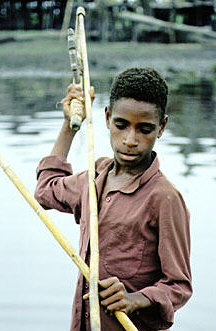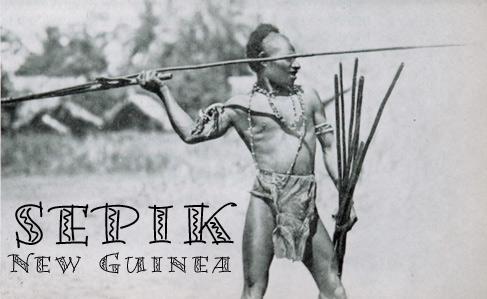Using a Papua New Guinea Spearthrower
The Papua New Guinea style spearthrower is an odd type, completely unlike anything else in the world. It comes from Indonesia (the collection of large and small islands between Australia and Asia), and is characterized by having a female socket for the spear and a dart guide or shelf mounted on the shaft. It's hard to find a native word for this, because the inhabitants of Papua New Guinea speak over 1,000 languages. I have found a few, though.
To the Iatmul people, it is known as a "wonpela samting throway sipir". This is probably a pidgin English (mixed-language) term. To the Tok Pisin people, it is known as a "spia", and the Sepik people call it a "gopsalong" (another pidgin English term).
The spia is a very difficult style to use correctly. For one thing, it doesn't seem to fit in the hand well (because it's not a style we're familiar with) and for another, the darts used with it are completely different than the ones we commonly use. Theirs are longer, thicker, and unfletched. From the ones I've seen, they average about 7' or more in length and 3/4" or more in diameter with little taper.
There are two ways to throw with the spia: with the dart guide almost vertical and with it turned at a 90 degree angle.
Throwing Vertically:
The easiest way to throw the dart is with the guide almost vertical. You simply put the dart in the socket and then use a thumb grip to hold it with the dart shaft resting against the guide. A variation of this is to wrap all of your fingers around the spia handle and use your thumb to press the dart against the guide, holding it in place (as seen in the picture).
Throwing Horizontally:
This seems to give better control while throwing but is much harder to do. Hold the spia sideways with the guide pointing out, away from your body. The dart goes into the female socket, then comes up and over the dart guide. Use a thumb grip to hold it. The tension from being twisted gives the dart more force, but it's very hard to keep it in place.



